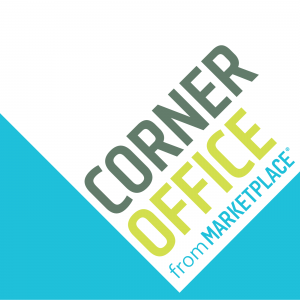
Pabst Brewing Company is perhaps best known for Pabst Blue Ribbon, or PBR, a beer the 175-year-old company has sold for over a century.
But while the beer name and its signature blue ribbon label have stayed pretty much the same for decades, the company itself hasn’t. Nearly two decades ago, Pabst nearly disappeared. When hipsters picked PBR as their signature drink, however, business came roaring back.
Today, general manager Matt Bruhn has been tasked with transforming Pabst from a beer company to a beverage company, and he’s starting by introducing hard coffee and clear whiskey. He recently sat down with Kai Ryssdal for a taste test and to talk about about all things Pabst. Here’s an edited transcript of that conversation.
Kai Ryssdal: There will be those who listen to this interview who somehow have not heard of Pabst Blue Ribbon.
Matt Bruhn: Well, they’ve been living under a rock?
Ryssdal: Ah, you know, I don’t know …
Bruhn: 175 years, they should have heard of us by now.
Ryssdal: Well, Pabst for a long time was — and, look, I was not of legal drinking age — but it was in the same league as, like, Rheingold and Schlitz, right?
Bruhn: Yep.
Ryssdal: Old Milwaukee, probably?
Bruhn: Yes.
Ryssdal: And then it went away for a while in the public consciousness and then came back sort of — I’m going to use this word — in hipsterland.
Bruhn: Yeah, totally.
Ryssdal: Oh, you’re owning it. That’s interesting. Go on.
Sadly for us as a company, those hipsters who were, you know, mid-20s in 2003, got married, had kids and, you know, no longer drove culture in America.
Matt Bruhn, Pabst general manager
Bruhn: Oh, absolutely. Biggest brand in America in the 70s. Craters in the 80s. By 1999, it’s, you know, one tenth the size it was at its peak, and it’s dead. It’s literally declining at 20%. Without the hipsters from Portland, Brooklyn and around the country picking it up, it would be pretty much out of market by now. I mean, 2003 to 2010, give or take, the brand was just on fire. Sadly for us as a company, those hipsters that were, you know, mid-20s in 2003, got married, had kids and, you know, no longer drove culture in America. So our challenge now is to go beyond the hipster movement and make it the real choice of who’s coming through now and driving culture, and the people that drove culture in 2003 don’t look like the people driving culture now, right?
Ryssdal: And you’re doing it not with beer. Explain.
Bruhn: Well we’re doing it with —
Ryssdal: With beer, but.
Bruhn: With beer, we’ve done “in-beer” thinking. But we recognize not everyone drinks beer.
Ryssdal: Yeah.
Bruhn: We’ve launched alcoholic coffee. We’ve done a whiskey, which is a real remembrance to Jacob [Best], the original founder.
Ryssdal: Does it — I mean, we’re going to taste it here, in a bit — but does it taste like moonshine?
Bruhn: No. No, it’s it’s definitely not moonshine, that’s for sure. It took me 18 months to create it, so hopefully it doesn’t taste like moonshine.
Ryssdal: You did it? You’re the guy?
Bruhn: Yeah, the distiller and I — I had 12 years of experience in the spirits industry. The head distiller from New Holland distilling in Grand Rapids [Michigan] and I spent the last 18 months going through different mash bills, grain types, working through how we distill it. And look, it’s not going to be something you sip neatly, quietly by the fireside. It is something you’re definitely going to want to mix. But much like gin, or vodka, or blanco tequila, it’s made to mix right but it doesn’t have the harshness or the kind of pungency of a moonshine.

Ryssdal: You are building a brand here, right? How did you start thinking about it when you got this job, taking Pabst from what it was, you know, even with the hipsters, right, it’s different now than it was with the hipsters. Go.
Bruhn: One hundred percent. Yeah. So when I when I landed in L.A. and looked at the PBR brand, we’re like: OK. Here’s a brand that people have chosen to badge themselves as outside the kind of homogeneous, nationalized identity, right? So the stuff we’re launching, we’re not trying to go national with everything, we’re going hey, let’s try this in this market, this in this market, like, have heaps of bets. You know, I have a little bit here, a little bit there. We’ve got hard coffee going, we’ve got whiskey about to go. We’ve got a stronger seltzer. So we’re basically saying: How can we be as fast and innovative as possible in multiple places?
Ryssdal: And then you’ll pick the one that works. If all three hit, then you run with them, and if if it’s just the seltzer, then you go with the seltzer?
Bruhn: Yeah, pick a winner. They might all win and they all go, right? One might win and two might lose, but we’ll basically incubate and see what works.
Ryssdal: So in 10-ish years. Where is Pabst?
Bruhn: America’s biggest enhanced drink.
Ryssdal: Is that the lingo, “enhanced drink?”
Bruhn: Yeah. I mean, we make functional drinks right? And you have to be open-minded to what those functional drinks might contain. Look at this shift going on, we’ve now got functional waters, kombuchas, green teas in a bottle, matchas. We are in a constant search to make the liquid we put down our throat enhance our life, right?
For more interviews with CEOs from all kinds of industries, subscribe to the Corner Office podcast.













